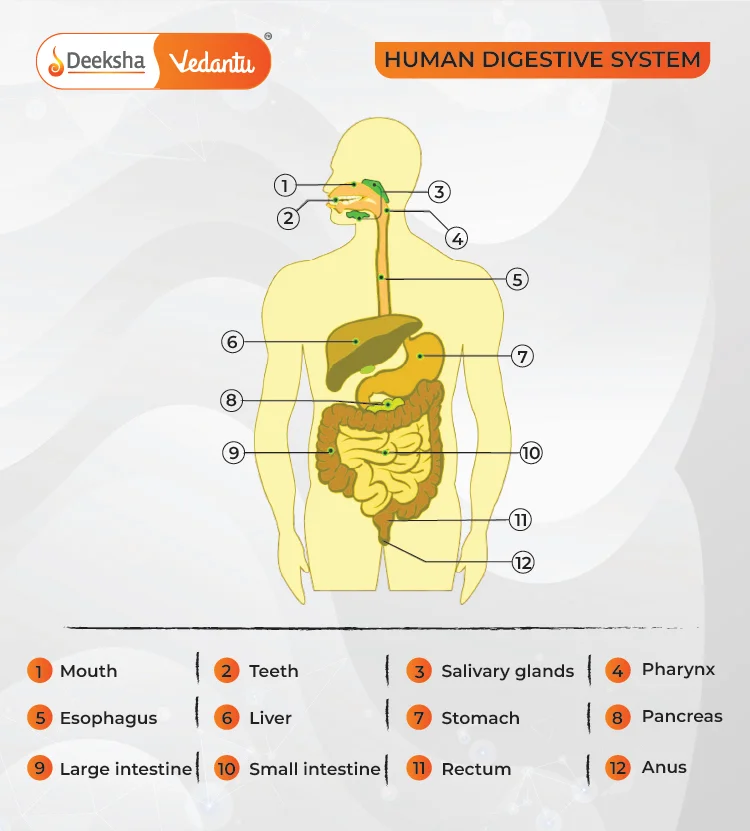Introduction to the Human Digestive System
The digestive system is a complex network of organs and glands that processes food. To use the food we eat, our bodies have to break the food down into smaller molecules that it can process; it also has to excrete waste.
Most of the digestive organs (like the stomach and intestines) are tube-like and contain the food as it makes its way through the body. The digestive system is essentially a long, twisting tube that runs from the mouth to the anus, plus a few other organs (like the liver and pancreas) that produce or store digestive chemicals.
Structure of the Human Digestive System
The human digestive tract begins at the mouth and terminates at the anus. Sandwiched between are the esophagus, stomach, small intestine, and large intestine, also known as the colon. Accessory structures include the teeth and tongue, salivary glands, liver, gallbladder, and pancreas.
Digestive Process Overview
- Ingestion The process starts when you eat. Food enters the digestive system through the mouth where the teeth, tongue, and salivary glands help moisten and break down the food into smaller pieces.
- Propulsion Swallowing and peristalsis (a series of wave-like muscle contractions) move food through the digestive tract.
- Mechanical Digestion The physical breakdown of large pieces of food into smaller pieces which can subsequently be accessed by digestive enzymes. In the stomach, the food is mixed with gastric juices, further breaking it down into a creamy paste called chyme.
- Chemical Digestion As food particles are mechanically broken down, enzymes and acids in the stomach and small intestine break them down into molecules small enough to be absorbed. The liver, pancreas, and gallbladder contribute their own digestive juices to aid in this complex process.
- Absorption The small intestine is the primary site of nutrient absorption. Millions of tiny hair-like structures called villi absorb nutrients into the bloodstream.
- Excretion Waste products of digestion (including parts of food that are still too large or those that can’t be digested) are expelled from the body via the rectum and anus.
Detailed Anatomy and Functions

- Mouth and Salivary Glands: Chewing starts the process of digestion. Saliva produced by the salivary glands contains enzymes that begin breaking down carbohydrates.
- Esophagus: A muscular tube that connects the throat (pharynx) with the stomach. The esophagus is responsible for moving swallowed food and liquids from the mouth to the stomach through peristaltic movements.
- Stomach: The stomach secretes acid and powerful enzymes that continue the process of breaking down the food into a usable form. Cells in the lining of the stomach secrete a strong acid and powerful enzymes that are responsible for the breakdown process. After the stomach, the food becomes semi-liquid and moves into the small intestine.
- Small Intestine: The small intestine is the ‘workhorse’ of digestion, as this is where most nutrients are absorbed. The small intestine has three segments – the duodenum, jejunum, and ileum. The liver produces bile that is stored in the gallbladder, and the pancreas delivers enzymes to the small intestine to aid in the digestion of fats, carbohydrates, and proteins.
- Large Intestine: Water is absorbed here and the remaining waste material is stored as feces before being removed by defecation.
Accessory organs:
- Liver: produces bile, which helps digestion and absorption of fats.
- Pancreas: produces digestive enzymes and bicarbonate, which neutralizes stomach acid.
- Gallbladder: stores and concentrates bile from the liver, releasing it when it is needed for digestion.
Common Digestive Problems
- Indigestion and Heartburn: Caused by stomach acid touching the lining of the esophagus.
- Constipation: Caused by too little fiber in the diet or inadequate water intake.
- Diarrhea: Can be caused by infections, certain medications, or chronic diseases.
- Irritable Bowel Syndrome (IBS): Affects the large intestine causing cramping, abdominal pain, bloating, gas, and diarrhea or constipation.
Conclusion
Understanding the human digestive system’s structure and function helps in diagnosing, treating, and preventing common digestive disorders. Maintaining a healthy digestive system is crucial for overall health and well-being, highlighting the importance of a balanced diet and regular physical activity.
FAQs
Common problems include indigestion, heartburn, constipation, diarrhea, and irritable bowel syndrome (IBS). These can be caused by a variety of factors, including diet, stress, and underlying medical conditions.
The large intestine absorbs water and salts from the material that has not been digested as food, and is thus crucial for maintaining the body’s fluid balance. It also serves as a storage place for waste before it is excreted from the body.
The small intestine is crucial for digestion and absorption. It is where most of the nutrients from ingested food are absorbed into the bloodstream. It utilizes enzymes secreted by the pancreas and bile from the liver to digest food completely.
The stomach mixes food with gastric juices, turning it into a semi-liquid substance called chyme. It also uses its muscular walls to physically break down food and uses enzymes and acids to perform chemical digestion.
The digestive process involves several steps: ingestion (eating), propulsion (moving food through the digestive system), mechanical digestion (breaking down food into smaller pieces), chemical digestion (breaking down food into simple molecules), absorption (taking nutrients into the bloodstream), and excretion (eliminating waste).
The human digestive system is primarily responsible for breaking down food into nutrients, which the body uses for energy, growth, and cell repair. It also plays a critical role in the excretion of waste products.










Get Social